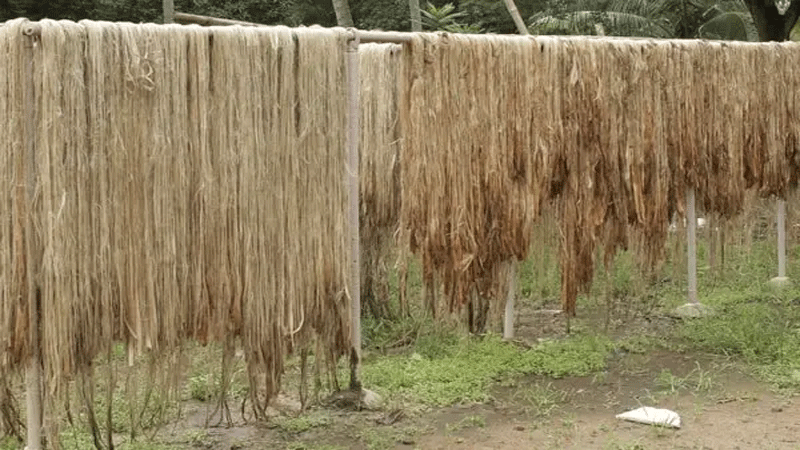Pakistan’s exports of jute and other textile fibre had seen the highest growth in the United Arab Emirates, Gambia, and the United Kingdom between 2019 and 2020.

Fibers like jute are well-known for their ability to be twisted into robust, coarse threads. Jute fibres themselves are considered to be long, silky, and lustrous in appearance. It is thought that plants from the genus Corchorus are the main sources of this fibre. It is important to remember that jute fibre is typically used to make burlap, hessian, and gunny fabric.
Pakistan’s exports of jute ($282k) and other textile fibre had seen the highest growth in the United Arab Emirates ($61.9k), Gambia ($22.8k), and the United Kingdom ($1.57k) between 2019 and 2020.
In terms of imports of jute and other textile fibres from Pakistan between 2019 and 2020, Bangladesh ($21.4 million), Montenegro ($23 thousand), and Sri Lanka ($22.7 thousand) had the fastest growth rates. Hence, Pakistan’s average tariff on jute and other textile fibres was 2.99%.
Jute, also known as Corchorus capsularis and Corchorus olitorius, is a subtropical crop whose bark is used to make fine commercial fibre. Both Corchorus capsularis and Colitorius are native to Africa and Indo-Burma, respectively.
Between 200 n lat and 300 s lat, it is mostly grown in India, Bangladesh, Brazil, and Taiwan. In the northern hemisphere, it is sown during the months of February and June. Brazil allows for the cultivation of two crops every year, the first in May to June and the second in November to December. The plants often grow between 4 and 5 metres tall. This crop shows plant height and fibre yield are positively connected.
The chemical composition of jute fiber includes cellulose (64.4%), hemicellulose (12%), pectin (0.2%), lignin (11.8%), water soluble (1.1%), wax (0.5%), and water (10%). Its comprises of 1.3-1.45 g/cm, 393-773 MPa tensile strength, 13-26.5 GPa Ypung Modulus, 1.16-1.5% Elongation at Break, 286-562 Mpa/g.cm-3 and 9-19 Gpa/g.cm-3 specific young modul.
Nutrient elements of Jute vegetable Energy (kcal)73.00, Carbohydrates (g)52.52, Dietary/crude fiber (g)6.80, Crude protein (g)3.77, Lipid (g)0.60, Calcium (mg)298.00, gIron (mg)11.00, Carotene (mg)1.92, Vitamin B-1 (mg) Thiamine15.00, Vitamin B-2 (mg) Riboflavin28.00 and Vitamin-C (mg)64.00.
Jute leaves are used in food in many countries around the world. It is used as a common vegetable, used to make soup or boil the leaves, added to daily rice diets, dried leaves are occasionally used as an alternative to coffee and tea, leaves sometimes used as a flavor, and typically cooked into a particular style of chicken stew unique in Turkey.
Jute leaves are also used in pharmaceuticals to treat ulcers, coughs, liver diseases, antinociceptive/anti-inflammatory, galactolipid/anti-tumour, capsugenin, headaches, and dysentery. A cute dysentery, antiseptics, Leaf infusion used as a febrifuge, for liver problems and for atonic dyspepsia. Because the vegetable contains beta-carotene, its vitamin content is beneficial for eyesight.
In order to build resistance against the threat of swine flu, the Philippine Department of Health urges the general public to increase their intake of jute leaf vegetables, including malunggay and bananas. The leaves have digestive, stimulant, laxative, demulcent, carminative, and demulcent properties.
Hessian, sacking, twines, ropes, and carpet backer cloth (CBC) are a few industrial goods that employ jute. However, if proper care is taken in the field of research and development, it could be used for a variety of other purposes in particular industries in addition to high-end textile products like blankets, furnishing fabrics, clothing, knitting yarns, jute-geotextile bags, and sanitary napkins.
There are numerous jute crop varieties being produced, released, and planted commercially at the farmer level. All of the leaf types have both culinary and medicinal uses. Several countries have employed jute leaf as a treatment for centuries.
The jute leaf contains approximately 17 nutritionally active substances, many of which are vitamins, minerals, and amino acids. Currently, it is believed that this multipurpose, adaptable plant component can treat a variety of human health issues. Although there are many natural medicines, jute leaf has a wide range of health advantages.
While jute leaf offers a wide range of qualities and applications, Protein, calories, fibre, and the anticancer compounds phytol and monogalactosyl-diacylglycerol are all present in jute leaf. It might reduce the cancer risk. In order to benefit from jute from all of these perspectives, the popularity of jute in the fibre sector has also been introduced.
In the future, controlled research will be necessary to demonstrate the efficacy of jute leaf in a variety of situations.